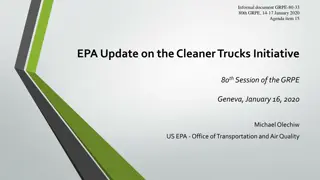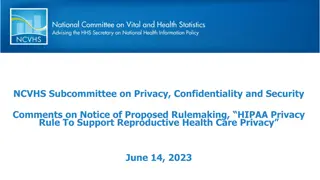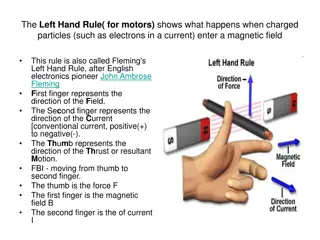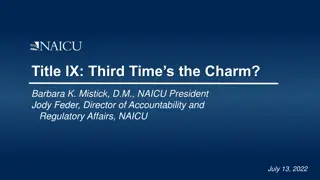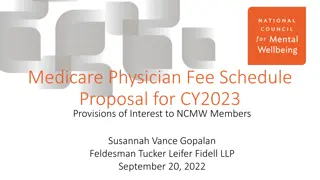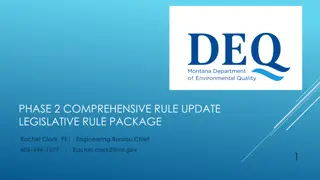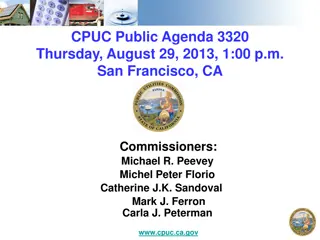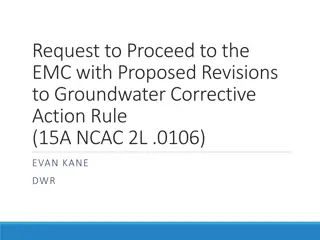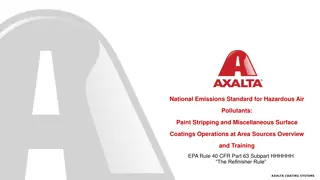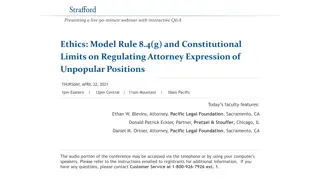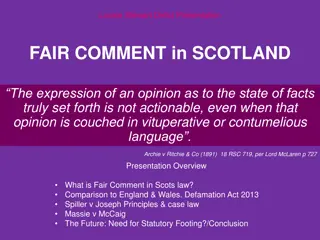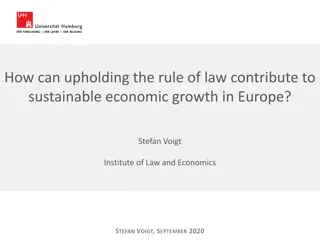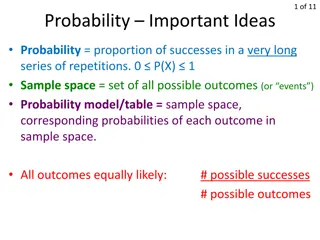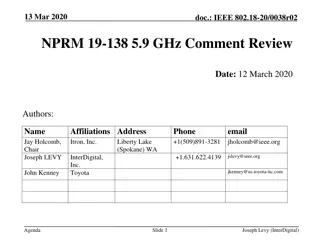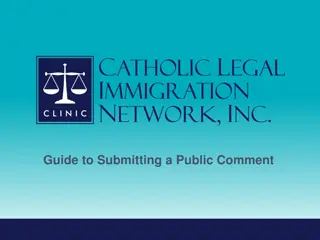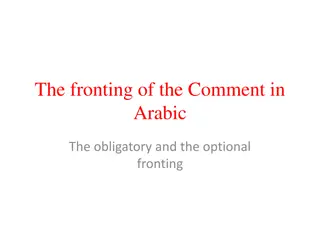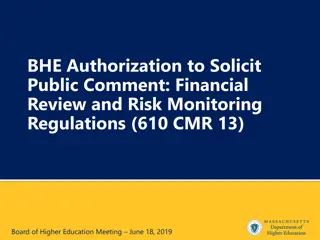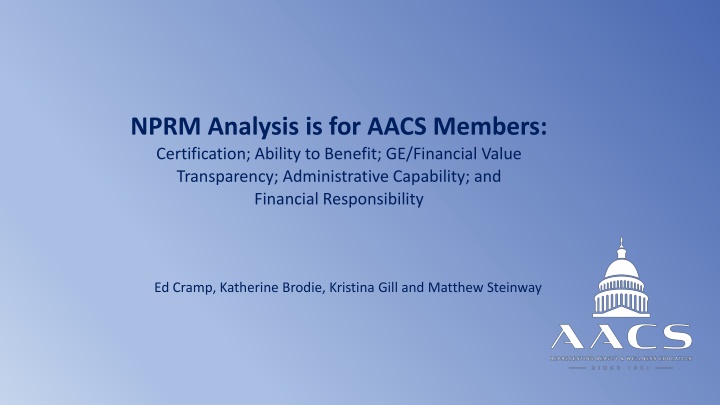
Analysis of NPRM for AACS Members: Certification Procedures and Financial Responsibility
Explore the NPRM analysis focusing on certification procedures, ability to benefit, financial transparency, administrative capability, and financial responsibility for AACS members. Key timelines, actions, and the importance of public comments and outreach highlighted.
Download Presentation

Please find below an Image/Link to download the presentation.
The content on the website is provided AS IS for your information and personal use only. It may not be sold, licensed, or shared on other websites without obtaining consent from the author. If you encounter any issues during the download, it is possible that the publisher has removed the file from their server.
You are allowed to download the files provided on this website for personal or commercial use, subject to the condition that they are used lawfully. All files are the property of their respective owners.
The content on the website is provided AS IS for your information and personal use only. It may not be sold, licensed, or shared on other websites without obtaining consent from the author.
E N D
Presentation Transcript
NPRM Analysis is for AACS Members: Certification; Ability to Benefit; GE/Financial Value Transparency; Administrative Capability; and Financial Responsibility Ed Cramp, Katherine Brodie, Kristina Gill and Matthew Steinway
Overview of Overview of NPRM (1) Certification Procedures NPRM (2) Ability to Benefit (3) Gainful Employment and Financial Value Transparency Financial Value Transparency (no Title IV consequences) Gainful Employment (Title IV consequences) (4) Administrative Capability (5) Financial Responsibility
Overview of Overview of NPRM NPRM NPRM references cosmetology program over 50 times GE Metrics: Debt-to-Earnings Rate ( D/E rate ) o Failure to account for underreporting in earnings o Removal of Alternate Earnings Appeals Earnings Premium Measure ( EP ) Immediate Extension Request from 30 to 60 days Public Comment Period Deadline is June 20, 2023 - VIA REGULATIONS.GOV - Re: Docket ID ED-2023-OPE-0089 School-Level GE Data Analysis
Timeline of Action ITEMS Timeline of Action ITEMS May 17, 2023: Release of Unofficial text of NPRM May 19, 2023: Release of official text of NPRM May 22, 2023: AACS publishes summary of NPRM May 22, 2023: AACS CONGRESSIONAL OUTREACH BEGINS May 24, 2023: First AACS webinar May 30, 2023: AACS Public Comment Templates Circulated May 31, 2023: Second AACS webinar June 7, 2023: Third AACS webinar June 14, 2023: Fourth AACS webinar June 20, 2023: Public Deadline
Next Steps Next Steps Public Comment and Outreach Public Comment and Outreach Essential that all AACS members, graduates, students, employers and allies file public comments objecting to onerous aspects of rule AACS cannot challenge any issue later in court not raised in public comment period Outreach to congressional members to pressure Department is critical
Important Resources Important Resources Notice of Proposed Rulemaking (5-19-2023): https://www.federalregister.gov/documents/2023/05/19/2023-09647/financial- value-transparency-and-gainful-employment-ge-financial-responsibility- administrative ED Release of version of the data that was used to model the effects of the proposed gainful employment and financial transparency rules in the Regulatory Impact Analysis: https://www2.ed.gov/policy/highered/reg/hearulemaking/2021/index.html
Important Resources Important Resources ED Press Release: https://www.ed.gov/news/press-releases/department-education- releases-proposed-rules-accountability-certificate-and-profit-programs-and- transparency-unaffordable-student-debt ED GE and Transparency Fact Sheet: https://www2.ed.gov/policy/highered/reg/hearulemaking/2021/gainful-employment- and-transparency-fact-sheet.pdf ED Fact Sheet on Admin Cap/Fin Resp/Certification/ATB: https://www2.ed.gov/policy/highered/reg/hearulemaking/2021/fact-sheet-for-other- may2023-nprm-issues.pdf
Certification Certification Title IV Max Hours Limit Title IV Max Hours Limit Current Regulation: Permits institution offer Title IV aid at maximum of: 150% of the minimum number of clock hours required for training in the recognized occupation for which the program prepares the student, as established by the state in which the program is offered, or as established by any federal agency. NPRM: Limits Title IV eligibility for clock hour programs to either: (a)100% of the state s minimum hours for where the institution is located, or under limited circumstances (b) 100% of another State s minimum hours
Certification Certification Other State Minimum Hours Other State Minimum Hours NPRM: Alternative of up to 100% of another State s minimum hours will only be applicable if the institution documents, with CPA substantiation, that: (1)A majority of students resided in that other State while enrolled in the program during the most recently completed Award Year (2)A majority of students who completed the program in the most recently completed Award Year were employed in that other State; or (3)The other State is part of the same metropolitan statistical area as the institution s home State and a majority of students, upon enrollment in the program during the most recently completed award year state in writing that they intend to work in that State.
Certification Certification Analysis Analysis AACS: Rule change will impact AACS members offering programs exceeding 100% of state minimum Rule change will impact AACS members offering short programs under 600 clock hours now Title IV eligible under 150% rule AACS Comment Letter Templates Will Include Sample Language on This Issue
Certification Certification Institutions at risk of closure submit an acceptable teach-out plan or agreement. Entities with direct or indirect ownership of a proprietary or private nonprofit institution sign the institution s Program Participation Agreement. This expands on guidance issued by the Department last year to seek these signatures on a case- by-case basis. Institutions may not employ, affiliate with, or contract with any individual or entity if the individual or entity has been found to have committed fraud or misconduct involving government funds, or was affiliated with another institution that owes a Title IV liability that is not being repaid.
Certification Certification Programs must meet any required programmatic accreditation and State licensure requirements so that students can obtain employment. Comply with all State consumer protection laws related to closure, recruitment, and misrepresentations for all States in which they enroll students. Do not withhold transcripts or take other adverse actions against a student related to a balance resulting from an error or fraud in the administration of Federal financial aid programs or a balance owed due to the Return of Title IV funds requirements. 2-3 year limit for provisional certification for any major consumer protection issues to be resolved
Provisional Certification Limitations Provisional Certification Limitations Non Exhaustive Limitations ED Can Establish Institution at risk of closure submit acceptable records retention plan that addresses title IV, HEA records and evidence of implementation Institution at risk of closure that is teaching out, closing, or that is not financially responsible or administratively capable, must release holds on student transcripts. Restrictions or limitations on the addition of new programs or locations; Restrictions on the rate of growth, new enrollment of students, or Title IV, HEA volume in one or more programs; Restrictions on the institution providing a teach-out on behalf of another institution;
Provisional Certification Limitations (continued) Provisional Certification Limitations (continued) Restrictions on the acquisition of another participating institution, which may include, in addition to any other required financial protection, the posting of LOC not less than 10 percent of the acquired institution s Title IV, HEA volume for the prior fiscal year; Additional reporting requirements, which may include, but are not limited to, cash balances, an actual and protected cash flow statement, student rosters, student complaints, and interim unaudited financial statements; Limitations on the institution entering into a written arrangement with another eligible institution or an ineligible institution or organization for that other eligible institution or ineligible institution or organization to provide between 25 and 50 percent of the institution s educational program For an institution alleged or found to have engaged in misrepresentations to students, engaged in aggressive recruiting practices, or violated incentive compensation rules, requirements to hire a monitor and to submit marketing and other recruiting materials (e.g., call scripts) for the review and approval of the Secretary.
Ability to Benefit Ability to Benefit Key Theme: VALUE derived from program Department achieved consensus in negotiating changes Proposed regulations reflect consensus language Proposed regulations establish safeguards to ensure State processes are adequate Establish documentation requirements for institutions that wish to enroll ATB students Establish verification process to ensure regulatory compliance Regulations define eligible career pathway program (Department achieved consensus in negotiating these changes and proposed regulations reflect consensus language)
Gainful Employment and Gainful Employment and Financial Financial Value Transparency Value Transparency Gainful Employment Applies to nearly all programs at for-profit institutions and non-degree programs, including diploma and certificate programs at public and private nonprofit institutions Financial Value Transparency Applies to all programs at all institutions, including public, private nonprofit institutions, and for-profit institutions Metrics Debt to Earnings (D/E)- annual and discretionary Earnings premium (E/P)
Gainful Employment and Gainful Employment and Financial Financial Value Transparency Value Transparency Debt to Earnings (D/E) Metric A GE program D/E rates of 20% for discretionary and 8% for annual, no zone Measured at the 6 digit CIP code Debt will include private and institutional loans, capped at tuition and fees less institutional grants and scholarships Federal agency earnings will be obtained from a Federal agency (SSA, IRS, Census Bureau, or HHS) No alternate earnings appeal Program ineligible if fails D/E 2 of 3 years
Gainful Employment and Gainful Employment and Financial Financial Value Transparency Value Transparency Earnings Premium Metric - Earnings Threshold is Calculated on Census Bureau income data for a working adult aged 25-34 with a high school diploma or GED In the state in which the institution is located or Nationally if less than 50% of students are in the state where the school is - Earnings Threshold Measure Pass: Median Annual Earnings for program cohort exceeds EP Fail: MAE less or equal to EP - Program ineligible if fail EP 2 of 3 years
Gainful Employment and Gainful Employment and Financial Value Transparency Financial Value Transparency Definitions Student: For the purposes of subparts Q and S, a student is defined as an individual who received title IV, HEA program funds for enrolling in the program. Amortization Period: 10-year repayment period for a program that leads to an undergraduate certificate Interest Rate: For an undergraduate certificate program, if the two-year cohort period is award years 2024- 2025 and 2025-2026, the interest rate would be the average of the interest rates for the years from 2023- 2024 through 2025-2026 Cohort Period: A two-year cohort period would consist of the third and fourth award years prior to the year for which the most recent data are available at the time of calculation.
Gainful Employment and Gainful Employment and Financial Value Transparency Financial Value Transparency Timing - - - - November 1, 2023-Projected Final Rule July 1, 2024- Effective Date July 31, 2024- Institutions must report data to Department Late 2024 or early in 2025- the first D/E rates and earnings premium rates calculated to assess financial value for award year 2024-2025 would be calculated in
Gainful Employment and Gainful Employment and Financial Value Transparency Financial Value Transparency Timing Programs must pass both the D/E and E/P metrics to pass a given award year. A program that fails 2 of 3 consecutive award years becomes ineligible. If the program becomes ineligible under the GE framework, its participation in the title IV, HEA program ends upon the earliest of 1) The issuance of a new Eligibility and Certification Approval Report that does not include that program; 2) The completion of a termination action of program eligibility, if an action is initiated under subpart G of this part; or 3) A revocation of program eligibility, if the institution is provisionally certified
Debt Debt- -to to- -Earnings Rate (D/E Rate) Earnings Rate (D/E Rate) Revives D/E rate introduced in 2014 GE Rule Disregards underreporting of income Elimination of Alternative Earnings Appeals Two D/E rates for each award year: Discretionary D/E rate: Rate 20% Annual D/E rate: Rate 8% Failure = high-debt burden Annual Earnings Rate = Annual Loan Payment Annual Earnings Discretionary Income Rate = Annual Loan Payment Discretionary Income
D/E Rate D/E Rate Annual Earnings Rate Annual Earnings Rate Annual Earnings Rate: Estimate proportion of annual earnings that students who complete program would need to devote to annual debt payments Annual Loan Payment: Taking median loan debt and amortizing it over 10, 15, or 20 year period (depending on program length) o Median Loan Debt: Completers during cohort period o Based on lesser of loan debt incurred by each student or total amount for tuition, fees, and books; equipment; and supplies for each student; LESS o Amount of institutional grant or scholarship funds provided to that student o Amortization Period: o 10 Year Repayment: Undergraduate Certificate o 15 Year Repayment: Bachelor/Masters Degree o 20 Year Repayment: Other Program o Interest Rate: Average of annual statutory interest rates based on Federal Direct Unsubsidized Loans based on level of program o Undergraduate certificate programs, post-baccalaureate certificate programs, and associate degree programs average interest rate would reflect three consecutive award years
D/E Rate D/E Rate Annual Earnings Rate (Continued) Annual Earnings Rate (Continued) Annual Earnings: Earnings data provided by a federal agency with earnings data, as defined in 668.2 o Agencies: Treasury Department (including the Internal Revenue Service), the Social Security Administration ( SSA ), the Department of Health and Human Services ( HHS ), and the Census Bureau o Agency provides median annual earnings of students on Federal agency list, in aggregate not individual form o Agency provides number of students on list that Federal agency could not match o Measures earnings using median of program completers earnings, not maximum of mean or median of completers earnings o If not possible to calculate D/E rate for award year, program would not receive D/E rate for award year and remain in same status as previous award year
D/E Rate D/E Rate Discretionary Income Rate Discretionary Income Rate Discretionary Income Rate: Measure the proportion of annual discretionary income amount of income above 150% of Poverty Guideline that completers need to devote to annual debt payments - If not possible to calculate D/E rate for award year, program would not receive D/E rate for award year and remain in same status as previous award year
D/E Rate D/E Rate Department v. Department v. AACS AACS Position Position Underreporting of Income + Elimination of Alternate Earnings Appeal Department: o Acknowledging would be harmful to taxpayers resulting in increasing public subsidies of such programs o Would not result in more accurate earnings o Not affect institution satisfying metric o Contrary to legal reporting requirements (and encourage behavior) o Assist institutions in gaming earnings data AACS: Without mechanisms in place, rate fails to accurately serve its purpose of ensuring programs lead to gainful employment o AACS v. DeVos: Department violated APA by failing to address issue of unreported income o Entrepreneurs and underreporting o Flexible work hours to supplement family income o AACS v. DeVos: Ordered removal of barriers to appeal to uphold legality of rule
Earnings Premium Measure Earnings Premium Measure New measure established during Negotiated Rulemaking process Measures extent to which typical graduate of program out-earns typical individual with high school diploma or equivalent in same State in which program is located Purpose: To put graduates of post-secondary programs in better place following completion Borrowers need to be able to afford more than just loan payments Protects students from adverse borrowing outcomes prevalent among programs with very low earnings
Earnings Premium Measure (Continued) Earnings Premium Measure (Continued) If the measure is positive following comparison, it indicates that graduates of the program gain financially If not possible to calculate EP for award year, program would not receive EP for award year and remain in same status as previous award year Earnings Data See discussion in D/E rate The median earnings of high school graduates is about $25,000 nationally, which corresponds to the earnings level of a full-time worker at an hourly wage of about $12.50 (lower than the State minimum wage in 15 States)
EP Measure EP Measure Department v. Department v. AACS AACS Position Position Department: D/E rate alone is not sufficient to ensure that program is leading to gainful employment High default rate among students in programs that satisfy D/E thresholds but fail EP AACS: 41% of cosmetology programs will fail measure, lose Title IV eligibility and likely shut down (not accounting for programs that do not have EP data) Basing comparison of program graduate v. high school graduate for age purposes is flawed mechanism Cosmetology graduate measured three years after completion fails to capture average earnings in profession and earning trajectories
Severability Severability 668.409 establishes severability protections ensuring that if any financial value transparency provision under subpart Q is held invalid, remaining provisions continue to apply
Failure to Satisfy D/E Rate and EP Failure to Satisfy D/E Rate and EP Programs must pass D/E Rate and EP to pass given award year Program fails two of three consecutive award years becomes ineligible If program becomes ineligible under framework, its participation in Title IV ends upon earliest of: Issuance of new Eligibility and Certification Approval Report failing to include program Completion of termination action of program eligibility Revocation of program eligibility
Student Warning and Notice Student Warning and Notice NPRM adds 668.605 to require warnings to current and prospective students if GE program is at risk of losing Title IV eligibility Must specify content and delivery parameters of notifications Require that students acknowledge having seen warning before institution may disburse Title IV funds Warning include description of options to continue education in another program at institution in event of closure
Department Notification Requirements Department Notification Requirements For each award year, Department issues determination informing institution of following: D/E rate for each program EP for each program Result (Pass/Fail) For non-GE Program, requirement of student acknowledgement For GE Program, requirement of student acknowledgment warning For GE Program, ineligibility of Title IV timeline
Institution Reporting Requirements Institution Reporting Requirements Institutions required to report information no later than July 31 of year following date regulations take effect After initial reporting, for each subsequent award year institution required to report by October 1 following end of award year
GE & GE & FVT FVT Timing and Effective Enforcement Timing and Effective Enforcement Publication by November 1, 2023 results in effective date of July 1, 2024 Department Statement: We believe institutions will have had sufficient time to take any internal actions necessary to comply with final regulations.
Financial Responsibility Financial Responsibility Mandatory Triggers Mandatory Triggers Proposed Mandatory Triggers Required to pay debt or other liability that, when added to financial responsibility score calculation, results in a failure Subject to lawsuits by Federal or State actors or qui tam lawsuits where potential liability, when added to financial responsibility score, results in a failure (Note ED directed question re appropriateness of this trigger) At risk of losing access to Federal aid due to having high cohort default rates, failing 90/10 revenue requirement, or having significant share of aid in failing GE programs Inflating financial responsibility scores by making contribution to school that results in passing score followed by distribution after FY ends Debt covenants that could cause adverse conditions if Department places limitations on their access to Federal financial aid Declaring financial exigency or entering receivership
Financial Responsibility Financial Responsibility Discretionary Triggers Discretionary Triggers Proposed Discretionary Triggers Subject to adverse accreditor actions, such as show cause or probation Experiencing significant fluctuations in Federal aid volume Closing programs or locations that enroll significant shares of students Subject to adverse actions by State and other Federal agencies
Administrative Capability Administrative Capability Proposed Regulations Require institutions to provide adequate financial aid counseling and financial aid communications to students, including information on the cost of attendance and the sources and types of financial aid available to them Limit institution from having principal or affiliate whose misconduct or institutional closure contributed to significant liabilities to the Federal government Strengthen requirements that institutions develop and follow adequate procedures to evaluate the validity of a student s high school diploma Require institutions to provide adequate career services and, where required for completion of a credential or licensure, accessible clinical or externship opportunities Prohibit institutions from engaging in misrepresentations or aggressive and deceptive recruitment


